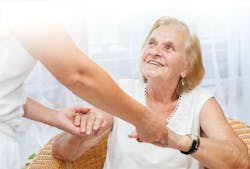Tailoring appointments: Geriatric patients
Older patients often present
with a lack of mobility and poor oral health habits
Treating geriatric patients can be very challenging, depending on the condition a patient is in when you see him or her. Does someone come to you from a group home? Is the person disabled, frail, or confused? I often find my geriatric patients are poorly cared for and visiting the dentist can be very nerve-racking for them. Like anything else, the way you choose to handle these situations reflects on the outcome. I have many tips and tools to help make these appointments go smoother and provide better compliance and outcomes for the patient.
Depending on a patient’s condition, I may treat them in their wheelchair. I offer a neck pillow and blanket to provide comfort. Many of my geriatric patients complain they’re freezing and cannot lie back because they get dizzy or have back and neck issues. I also recommend fluoride varnish treatment and have them pre- and post-rinse with mouthwash.
Here are my top five must-haves:
1. Pre-rinse with dry mouth rinse
2. Post-rinse with Listerine Total Care
3. Fluoride varnish
4. Oral hygiene instruction and nutrition education
5. Neck pillow
One patient I see is an 85-year-old woman who uses a walker. She’s frail, confused, and visits with a caseworker. She complains of generalized pain throughout her mouth. After taking her medical history and reviewing her medications with the caseworker, I found that she is on many medications that lead to xerostomia, and she is severely medically compromised.
She has had three heart attacks, had stents placed, and needs heart surgery, but she is not strong enough to undergo surgery. This leaves her weak and winded from little movement. She has diabetes and is headed toward dementia but isn’t quite there yet. She’s a very sweet lady, but when I see her, she has so much fear in her eyes.
At one appointment, 12 of her teeth were broken, every tooth had decay, and she had two infections. There was heavy plaque and calculus buildup with swollen gingiva generalized throughout her mouth, and her tongue was coated with a thick yellow appearance. My mirror kept getting stuck to her cheeks, and she was constantly asking for water. This broke my heart and also made me mad. Why wasn’t she getting better care?
This woman ended up receiving a full treatment of care, she now comes for regular checkups, and she’s doing much better with her hygiene. But this was after many conversations with her caseworker about oral health care at the facility. I recommended dry mouth supplements, provided education for the staff concerning proper care for patients’ teeth, and recommended multiple options to help the staff and patient clean her teeth properly.
Here are my top three dexterity options:
• A tennis ball on the bottom of a toothbrush will help patients with gripping issues.
• GumChucks will help patients floss and the staff assist with flossing.
• GUM toothbrushes have handles that can bend, making it easier for staff to get the toothbrush in a patient’s mouth at the correct angle.
Other options are using putty or Play-Doh to build up the base of toothbrush handles for a wider grip, interproximal brushes on handles for both patient and staff-assisted cleaning, and in the right settings, an electric toothbrush and/or Waterpik are great tools.
I believe education for staff and patients is a top priority because without the proper knowledge, how can someone use these tools effectively and understand the importance of oral health care? From denture care to oral hygiene instruction, nutrition, and medication-induced issues, these are the root of the problems that need to be addressed. Once we get a handle on these issues, then we can move forward with choosing the right tools.
Not all geriatric patients are like the case study I shared, but most do have one or two of these problems that they need help with. Xerostomia affects so many patients because people are on more medications than ever before. Knowing what to use is imperative to decreasing decay and keeping more teeth. On the opposite end of the spectrum, I have geriatric patients who still have all of their teeth and look amazing, but this is rare. Many geriatric patients still believe the myth that loss of teeth and the need for dentures are inevitable. It doesn’t have to be this way, and the more we educate and provide prevention, the more we can be part of the change!
My top three dry mouth supplements
- Biotène and Oasis
- ACT dry mouth products
- SPRY lozenges or dry mouth slow melts
Recall
I recommend three- to four-month recalls for nearly all of my geriatric patients. This is due to their xerostomia and poor oral hygiene. I recommend keeping an eye on their dentures, and striving to reduce decay and increase prevention. Most of my patients are compliant and after a while are amazed at how good their mouths feel. We all have those noncompliant patients who are a struggle, but be tenacious and keep educating.
Home care
Taking care of their teeth at home can be a challenge for geriatric patients and lead to discouragement and neglect. Patients from group homes or convalescent homes often struggle with getting proper oral care. Education and follow-through with positive reinforcement are necessary. Staff at group homes are often overwhelmed and appreciate any positive feedback. By recommending a three- to four-month recall, I can evaluate how my recommended products are working, and I help patients and caregivers work through any issues.
Katie Melko, RDH, MSDH, is a public health hygienist at Community Health Center Inc. She graduated from Fones School of Dental Hygiene at the University of Bridgeport in 2016 with an MSDH. She has practiced dental hygiene since 2009.

